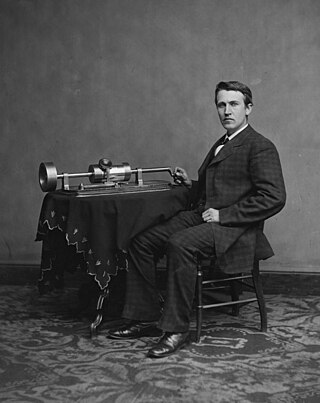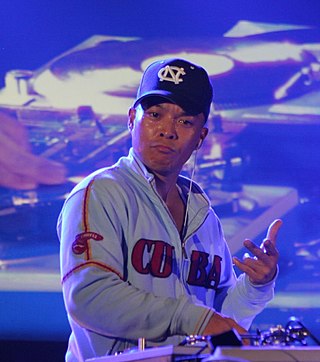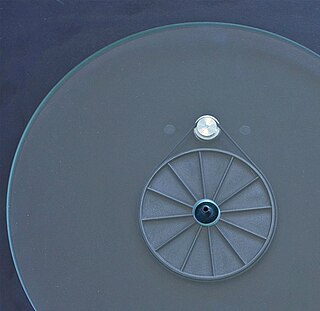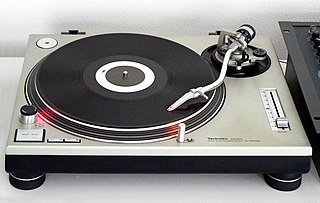
Beatmatching or pitch cue is a disc jockey technique of pitch shifting or time stretching an upcoming track to match its tempo to that of the currently playing track, and to adjust them such that the beats are synchronized—e.g. the kicks and snares in two house records hit at the same time when both records are played simultaneously. Beatmatching is a component of beatmixing which employs beatmatching combined with equalization, attention to phrasing and track selection in an attempt to make a single mix that flows together and has a good structure.

A disc jockey, more commonly abbreviated as DJ, is a person who plays recorded music for an audience. Types of DJs include radio DJs, club DJs, mobile DJs, and turntablists. Originally, the "disc" in "disc jockey" referred to shellac and later vinyl records, but nowadays DJ is used as an all-encompassing term to also describe persons who mix music from other recording media such as cassettes, CDs or digital audio files on a CDJ, controller, or even a laptop. DJs may adopt the title "DJ" in front of their real names, adopted pseudonyms, or stage names.

A phonograph, in its later forms also called a gramophone or since the 1940s called a record player, or more recently a turntable, is a device for the mechanical and analogue recording and reproduction of sound. The sound vibration waveforms are recorded as corresponding physical deviations of a spiral groove engraved, etched, incised, or impressed into the surface of a rotating cylinder or disc, called a "record". To recreate the sound, the surface is similarly rotated while a playback stylus traces the groove and is therefore vibrated by it, very faintly reproducing the recorded sound. In early acoustic phonographs, the stylus vibrated a diaphragm which produced sound waves which were coupled to the open air through a flaring horn, or directly to the listener's ears through stethoscope-type earphones.

Scratching, sometimes referred to as scrubbing, is a DJ and turntablist technique of moving a vinyl record back and forth on a turntable to produce percussive or rhythmic sounds. A crossfader on a DJ mixer may be used to fade between two records simultaneously.

Turntablism is the art of manipulating sounds and creating new music, sound effects, mixes and other creative sounds and beats, typically by using two or more turntables and a cross fader-equipped DJ mixer. The mixer is plugged into a PA system and/or broadcasting equipment so that a wider audience can hear the turntablist's music. Turntablists atypically manipulate records on a turntable by moving the record with their hand to cue the stylus to exact points on a record, and by touching or moving the platter or record to stop, slow down, speed up or, spin the record backwards, or moving the turntable platter back and forth, all while using a DJ mixer's crossfader control and the mixer's gain and equalization controls to adjust the sound and level of each turntable. Turntablists typically use two or more turntables and headphones to cue up desired start points on different records.

A variable speed pitch control is a control on an audio device such as a turntable, tape recorder, or CD player that allows the operator to deviate from a standard speed, resulting in adjustments in pitch. The latter term "vari-speed" is more commonly used for tape decks, particularly in the UK. Analog pitch controls vary the voltage being used by the playback device; digital controls use digital signal processing to change the playback speed or pitch. A typical DJ deck allows the pitch to be increased or reduced by up to 8%, which is achieved by increasing or reducing the speed at which the platter rotates.

There are three main types of phonograph turntable drives being manufactured today: the belt-drive, idler-wheel and direct-drive systems; the names are based upon the type of coupling used between the platter of the turntable and the motor. In a belt-drive turntable the motor is located off-center from the platter, either underneath it or entirely outside of it, and is connected to the platter or counter-platter by a drive belt made from elastomeric material.

A slipmat is a circular piece of slippery cloth or synthetic materials disk jockeys place on the turntable platter instead of the traditional rubber mat.

Technics SL-1200 is a series of direct-drive turntables originally manufactured from October 1972 until 2010, and resumed in 2016, by Matsushita Electric under the brand name of Technics. S means "Stereo", L means "Player". Originally released as a high fidelity consumer record player, it quickly became adopted among radio and disco club disc jockeys, thanks to the direct drive, high torque motor design, making it initially suitable for pushbutton cueing and starting of tracks on radio and in dance clubs. It is still extremely popular with audiophiles.
Back spinning describes the act of manually manipulating a vinyl record, using enough force to cause the record to spin backward. It is often used in DJing; many DJs use specialty slipmats so that friction will be reduced between the record and the platter. Back spinning is used to "rewind" the sound on a record to a previous point in the audio, to slip cue or cut music mixed live by a DJ, or in beat juggling.

Michael Schwartz, better known by his stage name Mix Master Mike, is an American turntablist best known for his work with Beastie Boys.

A DJ mixer is a type of audio mixing console used by disc jockeys (DJs) to control and manipulate multiple audio signals. Some DJs use the mixer to make seamless transitions from one song to another when they are playing records at a dance club. Hip hop DJs and turntablists use the DJ mixer to play record players like a musical instrument and create new sounds. DJs in the disco, house music, electronic dance music and other dance-oriented genres use the mixer to make smooth transitions between different sound recordings as they are playing. The sources are typically record turntables, compact cassettes, CDJs, or DJ software on a laptop. DJ mixers allow the DJ to use headphones to preview the next song before playing it to the audience. Most low- to mid-priced DJ mixers can only accommodate two turntables or CD players, but some mixers can accommodate up to four turntables or CD players. DJs and turntablists in hip hop music and nu metal use DJ mixers to create beats, loops and so-called scratching sound effects.

Vestax Corporation was a Japanese musical instrument, turntable and audio equipment firm founded by Hidesato Shiino in 1977. The company started by designing and manufacturing electronic guitars. In the 1980s, Vestax produced multitrack recorders and later moved to making DJ mixers, professional turntables, CD players and signal processors. Debt troubles led to the company's bankruptcy at the end of 2014.

Hip hop production is the creation of hip hop music in a recording studio. While the term encompasses all aspects of hip hop music creation, including recording the rapping of an MC, a turntablist or DJ providing a beat, playing samples and "scratching" using record players and the creation of a rhythmic backing track, using a drum machine or sequencer, it is most commonly used to refer to recording the instrumental, non-lyrical and non-vocal aspects of hip hop.
Stanton Magnetics, doing business as Stanton, is a business unit of inMusic Brands that designs and markets turntables, cartridges, DJ mixers, DJ media players, and DJ controllers.
Technics is a Japanese brand name of Panasonic for audio equipment. Since 1965, Panasonic has produced a variety of hi-fi and audio products under the brand name, such as turntables, amplifiers, radio receivers, tape recorders, CD players, speakers, and digital pianos. Technics products were available for sale in various countries. The brand was originally conceived as a line of high-end audio equipment to compete against brands such as Nakamichi.

The Numark Pro TT-2, Pro TT-1+, Pro TT-1 and TT-100 were a family of private label, high end, direct drive DJ phonograph turntables sold by Numark during the late 1990s and early 2000s. Only in production for a few years, these models were among the early versions of the "Super OEM" manual DJ turntables made by the Hanpin Electron Co., Ltd. of Taiwan. The Pro TT-1, Pro TT-1+, and Pro TT-2 models incorporated a LCD display on the top plate to show turntable settings which included a unique 12 segment animated element to indicate platter rotation and direction.

Joseph Robert Saddler, popularly known by his stage name Grandmaster Flash, is a Barbadian DJ and producer. He created a DJ technique called the Quick Mix Theory. This technique serviced the break-dancer and the rapper by elongating the drum breaks through the use of duplicate copies of vinyl. This technique gave birth to cutting and scratching. It also gave rappers better music with a seamless elongated bed of beats to speak on. He also invented the slipmat.
The Technics SL-J2 is a quartz-controlled direct-drive fully automatic turntable system produced by Technics between 1984 and 1988. It features a linear tracking tonearm with an optical sensor that allows for the kind of track-skipping more typical of CD players. The sensor also detects the size of the record sitting on the platter, which allows the needle to drop precisely on the first track.

DJing is the act of playing existing recorded music for a live audience.
















